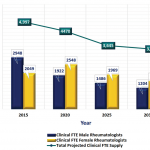This attention is excellent news for our specialty. The trend also bodes well for our patients and can help serve to maintain and, hopefully, expand the rheumatology workforce. Although current healthcare policy makers don’t appreciate the workforce issue in rheumatology, anyone in practice knows a shortage of rheumatologists already exists. Our projections indicate demand will continue to outpace the availability of trained rheumatologists.
The shortage of physician scientists is likely to become even more acute. This reality emphasizes the importance of working to generate similar interest in the field among allied physician assistants and nurse practitioners, of advocating for more training positions for adult and pediatric rheumatology fellows, and of supporting programs to foster the careers of young physician scientists. It also underscores the importance of advocating against measures that increase the burden and threaten the viability of rheumatology practice.
Impact of Change
Progress can be rapidly halted. We experienced such an effect in the 1990s, when the adoption of the primary care gatekeeper model by managed care and inaccurate workforce projections predicting an excess of rheumatologists led to a drop in rheumatology fellowship applications. Thus, we must continue to advocate for rheumatology training and practice.
The arrival of younger generations of rheumatology providers in the workforce also will affect the field. These talented and idealistic professionals will accelerate innovation and bring new energy to the specialty, and the responsibility lies with us to foster their careers and accommodate their needs and goals. This is a major reason why the ACR has adopted a plan for moving younger members into leadership roles—a plan that is already showing success.
Finally, change will inevitably come as we identify a new executive vice president (EVP) to lead the vision and the talented staff and operations of the ACR. The success and innovation the ACR has achieved over the past 30 years is due, in no small part, to the leadership of Mark Andrejeski, who has served as the EVP over this entire period of time. It is now the responsibility of the search committee and Board of Directors to identify a new executive who can effectively manage and innovate to meet coming challenges.
Of course, challenges spawn opportunity. To realize and optimize our opportunities we must be proactive in identifying and promoting the quality and value we bring to medical research into the rheumatic and musculoskeletal diseases and the and clinical care we provide patients. The precipitous actions by policy makers that we that we are seeing now underscore the need to become more involved as individuals in advocating for our specialty and for our patients. We must continue to work together as a single organization of community-based clinicians, academicians and allied health professionals in support of our common goals and our patients.



